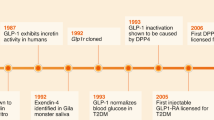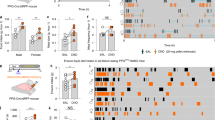Abstract
Multiple gut peptides are involved in the overall control of food intake. Plasma levels of gut peptides are differentially affected by food intake, and the different patterns of release around meals provides an indication of a peptide's specific role in feeding control. Ghrelin is a gastric peptide whose plasma levels are high before meals and are suppressed in response to food intake. Consistent with this pattern, ghrelin has been shown to stimulate food intake by hastening meal initiations. Cholecystokinin (CCK) is released from upper intestinal sites in response to food intake. CCK inhibits eating in a manner consistent with a role in satiety. Pancreatic glucagon and amylin play similar roles in meal termination. In contrast, the lower gut peptides, peptide YY (3–36) and glucagon-like peptide 1, are released more slowly in response to food intake and levels remain elevated for hours after a meal. This pattern of release suggests effects across multiple meals, and these peptides have been shown to inhibit food intake by both decreasing meal size and increasing the satiating potency of consumed nutrients. Together, these actions indicate multiple roles for gut peptides in feeding control.
This is a preview of subscription content, access via your institution
Access options
Subscribe to this journal
Receive 12 print issues and online access
$259.00 per year
only $21.58 per issue
Buy this article
- Purchase on Springer Link
- Instant access to full article PDF
Prices may be subject to local taxes which are calculated during checkout
Similar content being viewed by others
References
Ritter S, Ritter JB, Cromer L . 2-Deoxy-D-glucose and mercaptoacetate induce different feeding patterns of macronutrient ingestion. Physiol Behav 1999; 66: 709–715.
Cummings DE, Purnell JQ, Frayo RS, Schmidova K, Wisse BE, Weigle DS . A preprandial rise in plasma ghrelin levels suggests a role in meal initiation in humans. Diabetes 2001; 50: 1714–1719.
Bagnasco M, Kalra PS, Kalra SP . Ghrelin and leptin pulse discharge in rats. Endocrinology 2002; 143: 726–729.
Wren AM, Small CJ, Ward HL, Murphy KG, Dakin CL, Taheri S et al. The novel hypothalamic peptide ghrelin stimulates food intake and growth hormone secretion. Endocrinology 2000; 141: 4325–4328.
Faulconbridge LF, Cummings DE, Kaplan JM, Grill HJ . Hyperphagic effects of brainstem ghrelin administration. Diabetes 2003; 52: 2260–2265.
Burdyga G, Varro A, Dimaline R, Thompson RG, Dockray GJ . Ghrelin receptors in rat and human nodose ganglia: putative role in regulating CB-1 and MCH receptor abundance. Am J Physiol Gastrointest Liver Physiol 2006; 290: G1289–G1297.
Arnold M, Mura A, Langhans W, Geary N . Gut vagal afferents are not necessary for the eating-stimulatory effect of intraperitoneally injected ghrelin in the rat. J Neurosci 2006; 26: 11052–11060.
Kinzig KP, Scott KA, Hyun J, Bi S, Moran TH . Lateral ventricular ghrelin and fourth ventricular ghrelin induce similar increases in food intake and patterns of hypothalamic gene expression. Am J Physiol Regul Integr Comp Physiol 2006; 290: R1565–R1569.
Cowley MA, Smart J, Rubinstein M, Cerdan M, Diano S, Horvath T et al. Leptin activates anorexigenic POMC neurons through a neural network in the arcuate nucleus. Nature 2001; 411: 480–484.
Asakawa A, Inui A, Kaga T, Katsuura G, Fujimiya M, Fujino MA et al. Antagonism of ghrelin receptor reduces food intake and body weight gain in mice. Gut 2003; 52: 947–952.
Tschop M, Smiley DL, Heiman ML . Ghrelin induces adiposity in rodents. Nature 2000; 407: 908–913.
Wortley KE, del Rincon JP, Murray JD, Garcia K, Iida K, Thorner MO et al. Absence of ghrelin protects against early-onset obesity. J Clin Invest 2005; 115: 3573–3578.
Liddle RA, Goldfine ID, Rosen MS, Taplitz RA, Williams JA . Cholecystokinin bioactivity in human plasma. Molecular forms, responses to feeding, and relationship to gallbladder contraction. J Clin Invest 1985; 75: 1144–1152.
West DB, Fey D, Woods SC . Cholecystokinin persistently suppresses meal size but not food intake in free-feeding rats. Am J Physiol 1984; 246: R776–R787.
Moran TH, Ameglio PJ, Peyton HJ, Schwartz GJ, McHugh PR . Blockade of type A, but not type B, CCK receptors postpones satiety in rhesus monkeys. Am J Physiol 1993; 265: R620–R624.
Moran TH, Norgren R, Crosby RJ, McHugh PR . Central and peripheral vagal transport of cholecystokinin binding sites occurs in afferent fibers. Brain Res 1990; 526: 95–102.
Schwartz GJ, McHugh PR, Moran TH . Gastric loads and cholecystokinin synergistically stimulate rat gastric vagal afferents. Am J Physiol 1993; 265: R872–R876.
Schwartz GJ, Tougas G, Moran TH . Integration of vagal afferent responses to duodenal loads and exogenous CCK in rats. Peptides 1995; 16: 707–711.
Moran TH, Baldessarini AR, Salorio CF, Lowery T, Schwartz GJ . Vagal afferent and efferent contributions to the inhibition of food intake by cholecystokinin. Am J Physiol 1997; 272: R1245–R1251.
Smith G, Jerome C, Norgren R . Afferent axons in the abdominal vagus mediate the satiety effects of cholecystokinin in rats. Am J Physiol 1985; 249: R638–R641.
Ritter RC, Ladenheim EE . Capsaicin pretreatment attenuates suppression of food intake by cholecystokinin. Am J Physiol 1985; 248: R501–R504.
Lutz TA, Geary N, Szabady MM, Del Prete E, Scharrer E . Amylin decreases meal size in rats. Physiol Behav 1995; 58: 1197–1202.
Le Sauter J, Geary N . Hepatic portal glucagon infusion decreases spontaneous meal size in rats. Am J Physiol 1991; 261: R154–R161.
Le Sauter J, Noh U, Geary N . Hepatic portal infusion of glucagon antibodies increases spontaneous meal size in rats. Am J Physiol 1991; 261: R162–R165.
Mollet A, Gilg S, Riediger T, Lutz TA . Infusion of the amylin antagonist AC 187 into the area postrema increases food intake in rats. Physiol Behav 2004; 81: 149–155.
Geary N, Smith GP . Selective hepatic vagotomy blocks pancreatic glucagon's satiety effect. Physiol Behav 1983; 31: 391–394.
Lutz TA, Mollet A, Rushing PA, Riediger T, Scharrer E . The anorectic effect of a chronic peripheral infusion of amylin is abolished in area postrema/nucleus of the solitary tract (AP/NTS) lesioned rats. Int J Obes Relat Metab Disord 2001; 25: 1005–1011.
Adrian TE, Ferri GL, Bacarese-Hamilton AJ, Fussel HS, Polak JM, Bloom SR . Human distribution and release of a putative new gut hormone, peptide YY. Gastroenterology 1985; 89: 1070–1077.
Holst JJ . Glucagon like peptide 1: a newly discovered gastrointestinal hormone. Gastroenterology 1994; 107: 1848–1855.
Batterham RL, Cowley MA, Small CJ, Herzog H, Cohen MA, Dakin CL et al. Gut hormone PYY(3-36) physiologically inhibits food intake. Nature 2002; 418: 650–654.
Chelikani PK, Haver AC, Reidelberger RD . Intravenous infusion of peptide YY(3-36) potently inhibits food intake in rats. Endocrinology 2005; 146: 879–888.
Moran TH, Smedh U, Kinzig KP, Scott KA, Knipp S, Ladenheim EE . Peptide YY (3-36) inhibits gastric emptying and produces acute reductions in food intake in rhesus monkeys. Am J Physiol Regul Integr Comp Physiol 2005; 288: R384–R388.
Abbott CR, Monteiro M, Small CJ, Sajedi A, Smith KL, Parkinson JR et al. The inhibitory effects of peripheral administration of peptide YY(3-36) and glucagon-like peptide-1 on food intake are attenuated by ablation of the vagal-brainstem-hypothalamic pathway. Brain Res 2005; 1044: 127–131.
Chelikani PK, Haver AC, Reidelberger RD . Intravenous infusion of glucagon-like peptide-1 potently inhibits food intake, sham feeding, and gastric emptying in rats. Am J Physiol Regul Integr Comp Physiol 2005; 288: R1695–R1706.
Scott KA, Moran TH . The GLP-1 agonist exendin-4 reduces food intake in non-human primates through changes in meal size. Am J Physiol Regul Integr Comp Physiol 2007; 293: R983–R987.
Acknowledgements
This work was supported by NIH Grant DK19302.
Author information
Authors and Affiliations
Corresponding author
Additional information
Conflict of interest
The author has declared no financial interests.
Rights and permissions
About this article
Cite this article
Moran, T. Gut peptides in the control of food intake. Int J Obes 33 (Suppl 1), S7–S10 (2009). https://doi.org/10.1038/ijo.2009.9
Published:
Issue Date:
DOI: https://doi.org/10.1038/ijo.2009.9
Keywords
This article is cited by
-
Role of gallic acid against hypothalamic oxidative stress and insulin resistance in diet-induced obesity
Comparative Clinical Pathology (2023)
-
Gastric ghrelin cells in obese patients are hyperactive
International Journal of Obesity (2021)
-
Gastrointestinal peptides in children before and after hematopoietic stem cell transplantation
BMC Cancer (2020)
-
A Cholecystokinin Receptor Antagonist Halts Nonalcoholic Steatohepatitis and Prevents Hepatocellular Carcinoma
Digestive Diseases and Sciences (2020)
-
Engineering of chimeric peptides as antagonists for the G protein-coupled receptor, RXFP4
Scientific Reports (2019)



